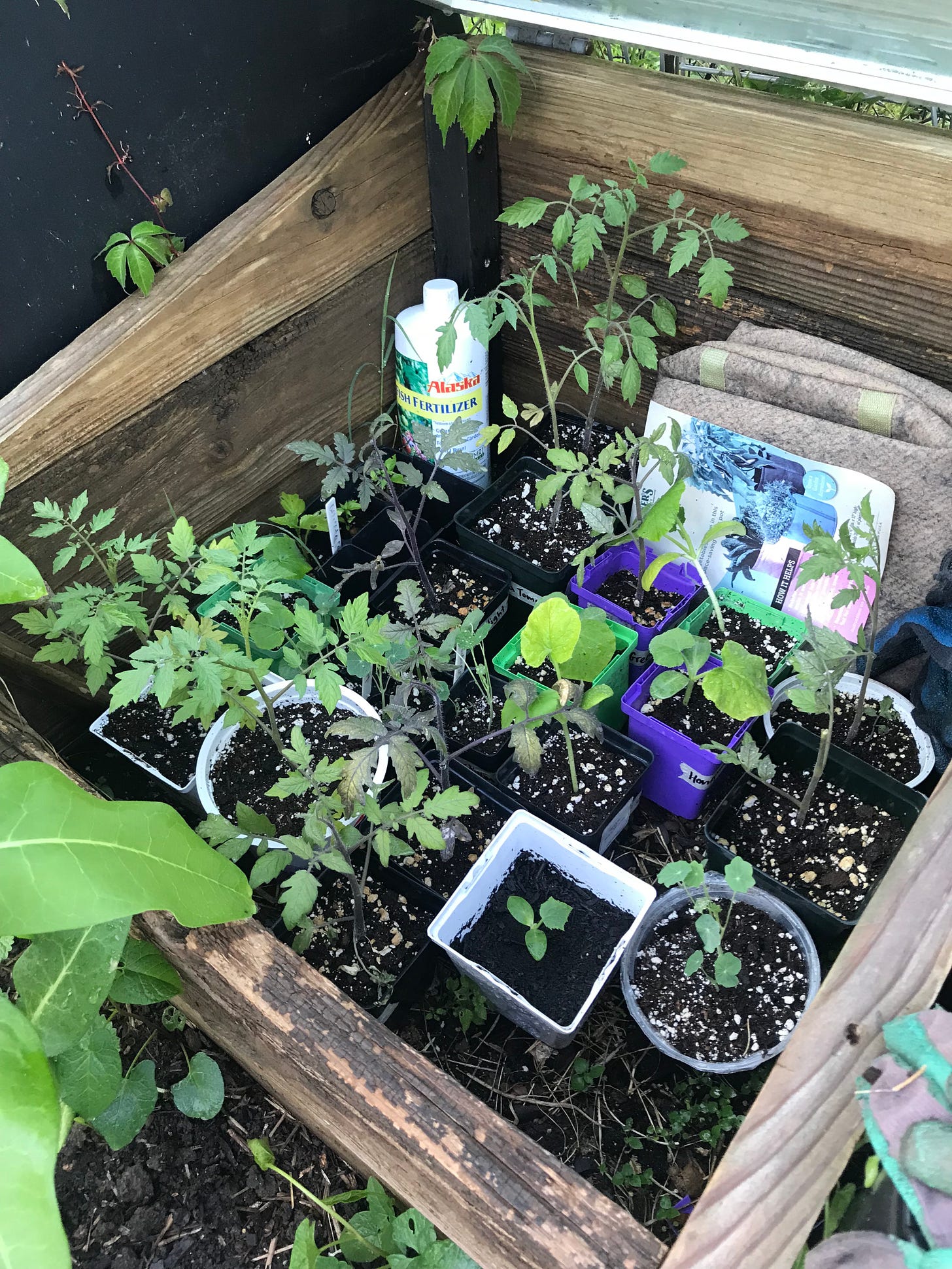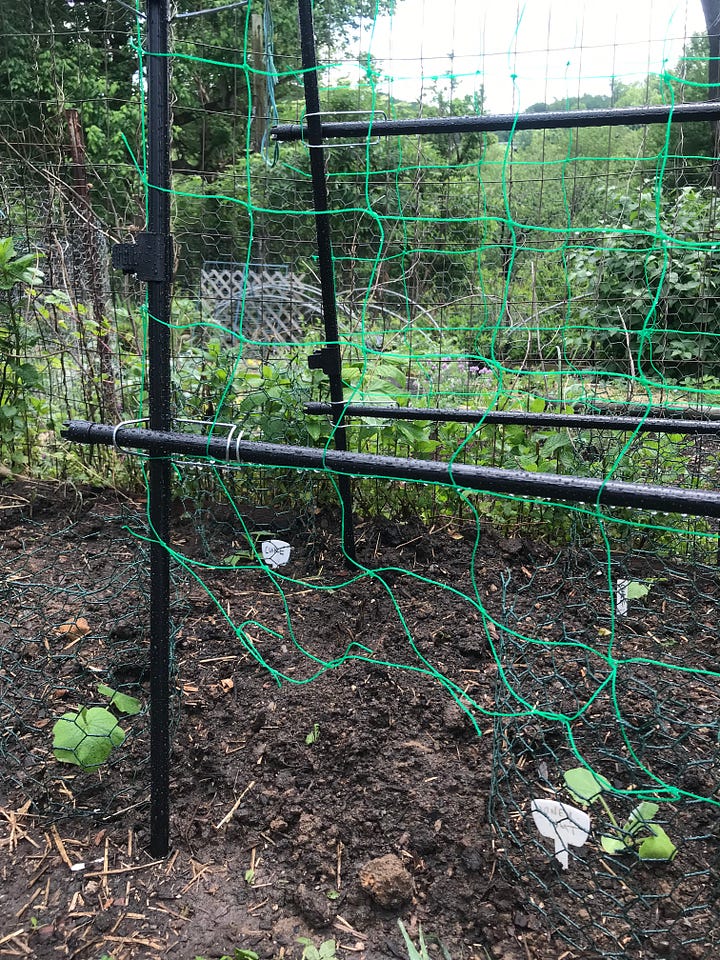I have been thinking lately about the concept of killing one’s darlings. As a writer, I know this adage to be annoyingly true: Almost every “perfect” sentence I write somehow gets in the way during later drafts. Often, writing that “perfect” phrase helps me unlock a more concise phrasing, so the darling serves its purpose. But in the end, it’s got to go.
It struck me, while watering my suddenly very full garden last week, that I needed to kill some darlings in the garden, too. Historically, I have been very, very bad at this. This is how, last summer, I ended up with leeks squeezed in next to tomatoes squeezed in next to green beans. Nothing had enough space. Nothing had enough light. The plants suffered because of my inability to make a firm choice, to kill my darlings.
My present predicament is this: It is time to plant tomatoes, but I do not have any room for them.
My kale is still going strong, right in the bed where the tomatoes go. The Landis winter lettuce I sowed back in April (or was it March?) is nearly big enough to pick now, so I’m hesitant to clear that out of the tomato bed, too. It turned out to be such a slow grower. It makes me sad to think it would only get one harvest. The rapini were also in that bed, but they had gone to seed so I pulled them up yesterday without much sorrow. It wasn’t that successful of a crop, yielding only teeny tiny florets that quickly flowered. I don’t think I’ll bother with them next year. Also, as a brassica, they tend to attract harlequin beetles. I’d already spotted a few and figured I’d pull the plants out before the pests got bad and moved to other people’s gardens. (Last year, I waited and waited for my romanesco to mature and the leaves were absolutely crawling with harlequin beetles. In the end, I had to pull them up for the sake of my neighbors.)
Although we had a run of 90-degree days a few weeks ago, it has overall been a pretty wet and chilly spring. Great weather for kale and lettuce, in other words. But my goal this year was to work my garden with a steadier hand, and that means making some tough decisions. It is warm enough for my tomatoes to get in the ground, and they’ve spent far too long in pots at this point. Pulling up the kale and lettuce (and eating one last delicious crop!) is the right thing to do.

I will, however, make one concession for my sugar snap peas. For some now unfathomable reason, I decided that the best place for them was smack in the middle of the kale/lettuce and soon to be tomato bed. These guys have a long way to go before they’re mature. I should have remembered that it wasn’t until June last year that I was harvesting them. So I’ll let them keep climbing for now. Sugar snap peas are one of the gardens most precious gifts.
It’s tempting, I think, to keep the spotlight on your star plants even when they’re past their prime. It pains me to pull up my tomatoes in the fall; I often put it off until early October. At that point, they’re only producing half-hearted fruits that are far from their August glamour. But it’s hard to resist the urge to keep summer alive just a little longer. When your garden is as small as mine, that kind of magical thinking has consequences. You want mid-October tomatoes? No beets for you!
I’m glad to be reckoning with this concept so early in the gardening year. Our gardens teach us something new each season — each day, really — and it’s a good feeling to finally take this lesson to heart. This week, I’ll be killing some darlings. But I’ll be eating them, too. And isn’t that kind of the point?
On Tap for May
There’s a day every year when I go down to the garden and am bowled over by how many things are happening at once. This year, that day was this past Saturday. Suddenly, there is much to do. Here are some of the top priorities.
Weeding. My garden had been fairly weed-free for the last few weeks but suddenly there are weeds everywhere — particularly a climbing vine I haven’t yet identified. My raspberry, as ever, is sending up suckers all over the garden. I had to get on top of those this weekend. I spent about an hour just weeding, and I still have more to do. Mint continues to be the biggest challenge to control, though it is a sensory pleasure to weed.
Transplant milkweed. Saturday also marked another garden milestone: My first monarch butterfly sighting of the year! Years ago, my dad divided up an especially vigorous milkweed plant in his garden and gave me half. I planted it in my garden and it’s been happily attracting pollinators ever since. More plants come back each year, but generally stay in their own corner. I’ve also spread the seed pods in the wildflower meadow next to our garden. Last year, however, they successfully seeded themselves all throughout my plot! I’m far too much of a softie to pull them up as weeds. I’ll be transplanting them over at the wildflower meadows.
Plant tomatoes. I got one tomato — Apricot Zebra — in a grow bag yesterday, but I’ve still got to plant all the others. (It hailed last night, so I hope it’s ok! Not a nice way to spend your first night in the ground.) Overall, the tomatoes are still looking ok, but I know they’ll appreciate the added space once they’re in the ground!


Organic pest abatement. Slugs continue to be a problem this year, but rabbits are making their presence known as well. I made small chicken wire enclosures for the squashes and cucumber seedlings I planted on Saturday. (Thanks to Rhiannon over at Liebemarlene Gardens for that tip! Much cheaper than buying pre-made cloches.) In previous years, I’ve quickly lost cucumbers and squashes to critters. I hope the enclosures help. I got a fantastic trellis for my birthday, and I’m eager to see my cukes and squashes climb it!





So happy the chicken wire is working! :)
And I'm with you on being too squeamish to get rid of plants. I stuffed too many sweet peas together in two big pots, and I finally got up the nerve to go cut some of them down. Can't imagine how mad I'd be if they all got powdery mildew just because I couldn't bare letting any precious seedlings go to waste!